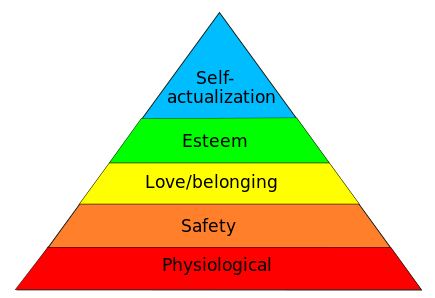
 Right!
Right!
Maslow's hierarchy of needs is a theory in psychology proposed by Abraham Maslow in his 1943 paper "A Theory of Human Motivation" in Psychological Review. Maslow subsequently extended the idea to include his observations of humans' innate curiosity. His theories parallel many other theories of human developmental psychology, some of which focus on describing the stages of growth in humans. Maslow used the terms "physiological", "safety", "belongingness" and "love", "esteem", "self-actualization", and "self-transcendence" to describe the pattern that human motivations generally move through. The different levels also broadly correspond to different stages of life. The basic physical needs at the bottom are predominant in infancy; safety needs come into focus in early childhood; belonging needs predominate in later childhood; esteem needs predominate in early adulthood and self-actualization only really comes into focus with mature adulthood.
Maslow termed peak experiences as profound, life-altering moments of love, understanding, happiness, bliss. They are moments in which one feels radically more whole, more completely alive, more aware of truth, beauty, goodness, and so on. These experiences are reached at the level of self-actualization. To actively seek these peak experenice is to seek self-transcendence.
In everyday language, "transcendence" means "going beyond", and "self-transcendence" means going beyond a prior form or state of oneself. Mystical experience is thought of as a particularly advanced state of self-transcendence, in which the sense of a separate self is abandoned.



